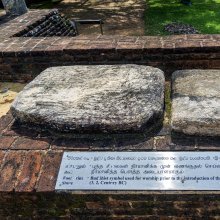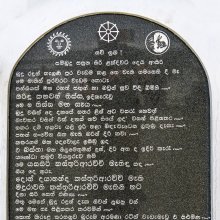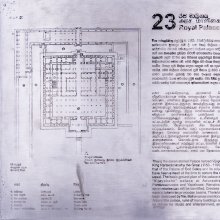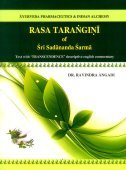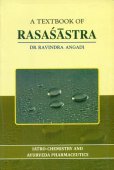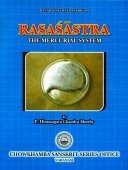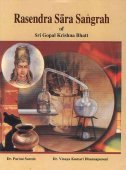Puta, Puṭa, Putā, Pūṭā: 31 definitions
Introduction:
Puta means something in Buddhism, Pali, Hinduism, Sanskrit, Marathi, Hindi, biology, Tamil. If you want to know the exact meaning, history, etymology or English translation of this term then check out the descriptions on this page. Add your comment or reference to a book if you want to contribute to this summary article.
Images (photo gallery)
In Hinduism
Ayurveda (science of life)
Rasashastra (Alchemy and Herbo-Mineral preparations)
Source: Wisdom Library: Rasa-śāstraPuṭa (पुट) is a Sanskit technical term referring to “burning pits” (used for calcination process of, for example, minerals). The term is used throughout Rasaśāstra literature.
Source: Academia.edu: Ayurveda and Pharmaceutics (rasashastra)Puṭa: Mercury, mica, gold and other similar raw material cannot be used in medicines without subjecting them to pāka (heating process) and this process is called bhasmīkarana (incineration). The Puṭa limits the degree of incineration. Literally Puṭa means hallow space or/in two vessels joined together. It is also a measure of heating arrangement for preparing various kinds of bhasma (cinder) of mahārasa, uparasa and loha etc. Although the Puṭa is an heating process, it entails elaborate arrangements and can be described under yantra. Yantras and puṭas have become very popular after the advent of rasaśāstra in the middle ages.
Source: Ancient Science of Life: Critical Review of Rasaratna SamuccayaPuṭa (पुट) refers to “various sized pits”, and mentioned in the Rasaratnasamuccaya: a 13th century C.E. alchemical treatise, authored by Vāgbhaṭa, is a useful compilation related to preparation and properties of drugs of mineral and metallic origin.
Unclassified Ayurveda definitions
Source: gurumukhi.ru: Ayurveda glossary of termsPuṭa (पुट):—A graded heating system used in preparation of bhasma of metals , minerals, marine products and medicines.

Āyurveda (आयुर्वेद, ayurveda) is a branch of Indian science dealing with medicine, herbalism, taxology, anatomy, surgery, alchemy and related topics. Traditional practice of Āyurveda in ancient India dates back to at least the first millenium BC. Literature is commonly written in Sanskrit using various poetic metres.
Natyashastra (theatrics and dramaturgy)
Source: Wisdom Library: Nāṭya-śāstra1) Puṭa (पुट) refers to the “eyelids”. It is one of the parts of the human body with which gestures (āṅgika) are performaned, according to the Nāṭyaśāstra chapter 8. These gestures of the eyelids (puṭa) are supposed to follow the corresponding nine movements of the eyeballs (tārā). These gestures form a part of the histrionic representation (abhinaya).
These are the nine gestures of the eyelids (puṭa), following the movements of the eyeballs (tāra):
- unmeṣa (opening),
- nimeṣa (closing),
- prasṛta (expanding),
- kuñcita (contracted),
- sama (level),
- vivartita (raising up),
- sphurita (throbbing),
- pihita (resting),
- vitāḍita (driven).
2) Puṭa (पुट) is another name for Paṭuvṛtta, which refers to a type of syllabic metre (vṛtta), according to the Nāṭyaśāstra chapter 16. In this metre, the first six and the tenth syllables of a foot (pāda) are light (laghu), while the rest of the syllables are heavy (guru).
⏑⏑⏑¦⏑⏑⏑¦⎼⎼⎼¦⏑⎼⎼¦¦⏑⏑⏑¦⏑⏑⏑¦⎼⎼⎼¦⏑⎼⎼¦¦
⏑⏑⏑¦⏑⏑⏑¦⎼⎼⎼¦⏑⎼⎼¦¦⏑⏑⏑¦⏑⏑⏑¦⎼⎼⎼¦⏑⎼⎼¦¦
Puṭa falls in the Jagatī class of chandas (rhythm-type), which implies that verses constructed with this metre have four pādas (‘foot’ or ‘quarter-verse’) containing twelve syllables each.
Source: Shodhganga: The significance of the mūla-beras (natya)Puṭa (पुट, “eyelids”) refers to one of the twelve “subsidiary limbs” (upāṅga), which represents a division of Āṅgikābhinaya (gesture language of the limbs) as used within the classical tradition of Indian dance and performance, also known as Bharatanatyam.—Āṅgika-abhinaya is the gesture language of the limbs. Dance is an art that expresses itself through the medium of body, and therefore, āṅgikābhinaya is essential for any dance and especially for any classical dance of India. Upāṅgas or the subsidiary limbs consist of the eyes, the eye-brows, [eyelids, viz., Puṭa], pupils, cheeks, nose, jaws, lips, teeth, tongue, chin, face, and the head.

Natyashastra (नाट्यशास्त्र, nāṭyaśāstra) refers to both the ancient Indian tradition (shastra) of performing arts, (natya—theatrics, drama, dance, music), as well as the name of a Sanskrit work dealing with these subjects. It also teaches the rules for composing Dramatic plays (nataka), construction and performance of Theater, and Poetic works (kavya).
Chandas (prosody, study of Sanskrit metres)
Source: Shodhganga: a concise history of Sanskrit Chanda literaturePuṭa (पुट) refers to one of the 135 metres (chandas) mentioned by Nañjuṇḍa (1794-1868 C.E.) in his Vṛttaratnāvalī. Nañjuṇḍa was a poet of both Kannada and Sanskrit literature flourished in the court of the famous Kṛṣṇarāja Woḍeyar of Mysore. He introduces the names of these metres (e.g., Puṭa) in 20 verses.

Chandas (छन्दस्) refers to Sanskrit prosody and represents one of the six Vedangas (auxiliary disciplines belonging to the study of the Vedas). The science of prosody (chandas-shastra) focusses on the study of the poetic meters such as the commonly known twenty-six metres mentioned by Pingalas.
Shaktism (Shakta philosophy)
Source: Google Books: ManthanabhairavatantramPuṭa (पुट) refers to a “capsule”, according to the Manthānabhairavatantra, a vast sprawling work that belongs to a corpus of Tantric texts concerned with the worship of the goddess Kubjikā.—Accordingly, “[...] (14) Once that has been abandoned and one travels upwards, (one reaches) the one called the Equal One (samanā), which is full of vitality (ojikā). This energy (kalā), established in the middle of the capsule of emission [i.e., visarga-puṭa-madhyasthā], rains down nectar. When consuming the Supreme Syllable, eat the energy which is nectar (amṛtakalā). [...] (Perfect) contemplation (samādhi) is with (these) sixteen aspects and is (attained) within the form of the sixfold deposition (ṣoḍhānyāsa). He who knows this is (a veritable) Lord of Yogis, the others (who do not) are (just) quoting from books. Once attained the plane that is Void and Non-void, the yogi is freed from bondage”.

Shakta (शाक्त, śākta) or Shaktism (śāktism) represents a tradition of Hinduism where the Goddess (Devi) is revered and worshipped. Shakta literature includes a range of scriptures, including various Agamas and Tantras, although its roots may be traced back to the Vedas.
Kavya (poetry)
Source: Brill: Śaivism and the Tantric Traditions (kavya)Puṭa (पुट) refers to the “cavities (of the ears)”, according to Bāṇa’s Kādambarī (p. 226).—There are apparently several Tantric rites that Bāṇa pejoratively associates with the priest: [...] “his collection of practices for mastering mantras for invisibility had grown”; “he was acquainted with a hundred tales about the marvels of the Śrīparvata mountain”; “his ear-cavities (śravaṇa-puṭa) were punched by those possessed by Piśāca-demons, who had run to him when struck by white mustard seed he had empowered with mantras more than once”.

Kavya (काव्य, kavya) refers to Sanskrit poetry, a popular ancient Indian tradition of literature. There have been many Sanskrit poets over the ages, hailing from ancient India and beyond. This topic includes mahakavya, or ‘epic poetry’ and natya, or ‘dramatic poetry’.
Shaivism (Shaiva philosophy)
Source: Brill: Śaivism and the Tantric TraditionsPūta (पूत) refers to “(having) purified”, according to the 13th-century Matsyendrasaṃhitā: a Kubjikā-Tripurā oriented Tantric Yoga text of the Ṣaḍanvayaśāmbhava tradition from South India.—Accordingly, “[...] He should treat [all phenomena] as one, not as separate. He should not drink [alcohol] or eat meat idly [with no ritual purpose]. He should not drink wine without first purifying it [with mantras], and he should consume meat after he has purified (pūta) it with that [wine]. He should not answer the call of nature, should not sip water, etc., while reciting mantras or in an assembly. If he does so out of folly, the curse of the Yoginīs will fall on him. [...]”.

Shaiva (शैव, śaiva) or Shaivism (śaivism) represents a tradition of Hinduism worshiping Shiva as the supreme being. Closely related to Shaktism, Shaiva literature includes a range of scriptures, including Tantras, while the root of this tradition may be traced back to the ancient Vedas.
Purana and Itihasa (epic history)
Source: archive.org: Shiva Purana - English TranslationPuta (पुत) refers to a “having sanctified (one’s body) (due to austerities)”, according to the Śivapurāṇa 2.3.35 (“The story of Padmā and Pippalāda”).—Accordingly, as Padmā (wife of sage Pippalāda) said to Dharma (in the guise of a king): “Away, away, go away you sinful king. If you cast your lustful ogles at me you will be doomed in a trice. How can I resort to you, lecherous and mad after women, after forsaking the excellent sage Pippalāda whose body is sanctified by austerities (pūta-vigraha)? By the very touch of a person under the influence of women all merits are destroyed. He is a great sinner. His very sight promotes sins. [...]”.

The Purana (पुराण, purāṇas) refers to Sanskrit literature preserving ancient India’s vast cultural history, including historical legends, religious ceremonies, various arts and sciences. The eighteen mahapuranas total over 400,000 shlokas (metrical couplets) and date to at least several centuries BCE.
In Buddhism
Tibetan Buddhism (Vajrayana or tantric Buddhism)
Source: MDPI Books: The Ocean of HeroesPuṭa (पुट) refers to the “four layers” (puṭa) of the Herukamaṇḍala: a five-fold maṇḍala that is widely taught in the scriptures belonging to the Saṃvara scriptural tradition.
The four layers (puṭa) are the:
- sahaja (“innate”),
- dharma ( dharma ),
- saṃbhoga (“enjoyment”), and
- nirmāṇa (“emanation”) Layers.
These four layers represent the Buddha’s fourfold body.

Tibetan Buddhism includes schools such as Nyingma, Kadampa, Kagyu and Gelug. Their primary canon of literature is divided in two broad categories: The Kangyur, which consists of Buddha’s words, and the Tengyur, which includes commentaries from various sources. Esotericism and tantra techniques (vajrayāna) are collected indepently.
Biology (plants and animals)
Source: Google Books: CRC World Dictionary (Regional names)Puta in India is the name of a plant defined with Commiphora mukul in various botanical sources. This page contains potential references in Ayurveda, modern medicine, and other folk traditions or local practices It has the synonym Balsamodendrum mukul Hook. (among others).
Example references for further research on medicinal uses or toxicity (see latin names for full list):
· The Annals of Pharmacotherapy
· Monographiae Phanerogamarum (1883)
· Ann. Pharmacother. (1984)
· Complementary Therapies in Medicine (2005)
· Hooker’s Journal of Botany Kew Gard. Misc. (1849)
· Am. J. Health Syst. Pharm.
If you are looking for specific details regarding Puta, for example pregnancy safety, chemical composition, health benefits, side effects, extract dosage, diet and recipes, have a look at these references.

This sections includes definitions from the five kingdoms of living things: Animals, Plants, Fungi, Protists and Monera. It will include both the official binomial nomenclature (scientific names usually in Latin) as well as regional spellings and variants.
Languages of India and abroad
Pali-English dictionary
Source: BuddhaSasana: Concise Pali-English Dictionarypuṭa : (m.; nt.) a container. (usually made of leaves); a pocket; a basket.
Source: Sutta: The Pali Text Society's Pali-English DictionaryPuṭa, (etym. unknown, prob. dialectical, as shown by N. of Pāṭaliputta, where putta=puṭa since unfamiliar in origin) orig. meaning “tube, ” container, hollow, pocket.—1. a container, usually made of leaves (cp. J. IV, 436; V, 441; VI, 236), to carry fruit or other viands, a pocket, basket: ucchu° basket for sugar J. IV, 363; paṇṇa° leaf-basket PvA. 168; phala° fruit basket J. IV, 436=VI, 236; phānita(ssa)° basket of molasses, sugar-basket S. I, 175 (KS. : jar); J. IV, 366; DhA. IV, 232; mālā° basket for garlands or flowers DhA. III, 212 (baddha made, lit. bound). In puṭa-baddha-kummāsa VvA. 308 perhaps meaning “cup. ” — 2. a bag or sack, usually referring to food carried for a journey, thus “knapsack” (or directly “provisions, ” taking the container for what it contains DA. I, 288 puts puṭaṃsa= pātheyya), in bhatta° bag with provisions J. II, 82 (with bandhati), 203; III, 200; DA. I, 270. Also at J. IV, 375 “bag” (tamba-kipillaka°). See below °aṃsa & °bhatta.—3. a tube, hollow, in nāsā° (nāsa°) nostril J. VI, 74; Vism. 195, 263, 362; KhA 65; hattha° the hollow of the hand Miln. 87; vatthi° bladder(—bag) Vism. 264; sippi-puṭa oyster shell J. V, 197, 206. puṭaṃ karoti to form a hollow VbhA. 34.—4. box, container, see °bheda & °bhedana, in pāṭali-puṭa seed box for the P. flower.
—aṃsa “bag-shoulder” (for “shoulder-bag, ” cp. aṃsapuṭa (assapuṭa) & Ger. rucksack=knapsack. Rightly explained by Bdhgh at DA. I, 288), a bag carrying provisions on journeys, hence “provision, ” in phrase puṭaṃsena with provisions (v. l. at all places puṭosena) D. I, 117; M. III, 80; A. II, 183; cp. Dialogues I. 150; see also mutoḷī.—pāka something cooked in a bag (like a meal-pudding) Vism. 500.—baddha kind of moccasins Vin. I, 186, see Vin. Texts II. 15. Spelt puṭa-bandha at Vism. 251=VbhA. 234.—bhatta “bag-food, ” viaticum, provisions for journey J. II, 423; KhA 46.—bheda the breaking of the container (i.e. seed boxes of the Sirīsa plant) VvA. 344 (in vatthu where Sirīsa refers to Pāṭaliputta, cp. Vv 8452, 53).—bhedana breaking of the (seed-) boxes of the Pāṭali plant, referring primarily to the N. of Pāṭali-putta, where putta represents a secondary Pālisation of Sk. °putra which again represents P. (or Non-Aryan) puṭa (see Pischel, Prk. Gr. § 238 & 292). Through popular etym. a wrong conception of the expression arose, which took puṭa in the sense of “wares, provisions, merchandise” (perhaps influenced by puṭaṃsa) and, based on C. on Ud. 88 (bhaṇḍakānaṃ mocara-ṭṭhānaṃ vuttaṃ hoti) gave rise to the (wrong) trsln Dial. II. 92 “a centre for interchange of all kinds of wares. ” See also Miln. trsln I. 2; Buddh. Suttas XVI, — Vin. I, 229=D. II, 87=Ud. 88. After the example of Pāṭaliputta applied to the city of Sāgala at Miln. 1 (nānā-puṭa-bhedanaṃ S° nagaraṃ). Here clearly meant for “merchandise. ” — Rh. D. in a note on puṭabhedana gives expln “a town at the confluence or bend of a river” (cp. Jaina Sūtras 2, 451). Puṭaka (nt.) (fr. puṭa) a bag, pocket, knapsack or basket J. II, 83 (°bhatta=provisions); DA. I, 263; DhA. II, 82 (v. l. piṭaka & kutaka); IV, 132 (pockets of a serpent’s hood). Cp. bhatta. (Page 464)

Pali is the language of the Tipiṭaka, which is the sacred canon of Theravāda Buddhism and contains much of the Buddha’s speech. Closeley related to Sanskrit, both languages are used interchangeably between religions.
Marathi-English dictionary
Source: DDSA: The Molesworth Marathi and English Dictionarypuṭa (पुट).—n (S) Anything folded or doubled so as to form a cup or concavity;--as the hands, leaves &c., a valve of a shell &c. Also in comp. as añjalipuṭa, cañcupuṭa, parṇapuṭa, karṇapuṭa. 2 A hemisphere. 3 A single application unto;--as, in preparing medicaments, of fire to bake, of sun, air &c. to dry: also a single dipping into an infusion, a single coating, plastering, smearing, overlay. Gen. in comp. as agnipuṭa, sūryapuṭa, auṣadhapuṭa, rasapuṭa. v dē. It signifies also the material so used,--the infusion, the plaster &c. 4 In comp. with nāsikā or nāsā or ghrāṇa, as nāsikāpuṭa &c. A nostril. 5 A crucible. Ex. jaisēṃ puṭīṃ paḍatāṃ suvarṇa || tējasvī disē daidīpyamāna ||.
--- OR ---
pūṭa (पूट) [or ठ, ṭha].—n From puṭa which see in its third sense. 2 Powdered substance, powder. 3 Foil, any material put in to set off. pūṭa karaṇēṃ or ghēṇēṃ To estimate and purchase the coming crop of fruit-trees (esp. of the jack, mango, and tamarind). pūṭa dēṇēṃ To sell the coming crop.
--- OR ---
pūta (पूत).—m (putra S through H) A son. Of restricted use. Ex. asō kōṇa māyīcā pūta āhē; pūta supūta kōṭhēṃ ōḷakhāvā jō dunyēmadhyēṃ nāṃva karīla.
--- OR ---
pūta (पूत).—p S Pure, purified, cleansed.
Source: DDSA: The Aryabhusan school dictionary, Marathi-Englishpuṭa (पुट).—n Anything folded so as to form a cup-as the hands, leaves. añjalipuṭa, cañcupuṭa. A hemisphere. A single appli- cation. A nostril. A crucible.
--- OR ---
pūṭa (पूट).—or-ṭha n Powder. Foil.
--- OR ---
pūta (पूत).—m A son.
--- OR ---
pūta (पूत).—p Pure. Purified.
Marathi is an Indo-European language having over 70 million native speakers people in (predominantly) Maharashtra India. Marathi, like many other Indo-Aryan languages, evolved from early forms of Prakrit, which itself is a subset of Sanskrit, one of the most ancient languages of the world.
Sanskrit dictionary
Source: DDSA: The practical Sanskrit-English dictionaryPuṭa (पुट).—[puṭ-ka]
1) A fold.
2) A hollow space, cavity, concavity; भिन्नपल्लवपुटो वनानिलः (bhinnapallavapuṭo vanānilaḥ) R.9.68;11.23; 17.12; M.3.9; अञ्जलिपुट, नासापुट, कर्णपुट (añjalipuṭa, nāsāpuṭa, karṇapuṭa) &c.
3) A cup made of a leaf folded or doubled; a vessel of leaves; दुग्ध्वा पयः पत्रपुटे मदीयम् (dugdhvā payaḥ patrapuṭe madīyam) R.2.65; Manusmṛti 6.28.
6) Any shallow receptacle.
5) The pod or capsule which envelops young shoots.
6) A sheath, cover, covering
7) An eye-lid (puṭī also in all these senses).
8) A horse's hoof.
9) A cloth worn to cover the privities.
-ṭaḥ 1 A casket.
2) The contracting of anything.
3) A folding of anything so as to form a cup.
-ṭam 1 A nutmeg.
2) Two vessels joined together for medical purposes.
Derivable forms: puṭaḥ (पुटः), puṭam (पुटम्).
--- OR ---
Pūta (पूत).—p. p. [pū-kta]
1) Purified, cleansed, washed (fig. also); दृष्टिपूतं न्यसेत् पादं वस्त्रपूतं जलं पिबेत् । सत्यपूतां वदेद् वाचं मनःपूतं समाचरेत् (dṛṣṭipūtaṃ nyaset pādaṃ vastrapūtaṃ jalaṃ pibet | satyapūtāṃ vaded vācaṃ manaḥpūtaṃ samācaret) || Manusmṛti 6.46; त्रैविद्या मां सोमपाः पूतपापा यज्ञै- रिष्ट्वा स्वर्गतिं प्रार्थयन्ते (traividyā māṃ somapāḥ pūtapāpā yajñai- riṣṭvā svargatiṃ prārthayante) Bhagavadgītā (Bombay) 9.2.
2) Threshed, winnowed.
3) Expiated.
4) Contrived, invented.
5) Stinking, putrid, fetid, foul-smelling.
-taḥ 1 A conch-shell.
2) White Kuśa grass.
-tam Truth.
-tā An epithet of Durgā.
Source: Cologne Digital Sanskrit Dictionaries: Edgerton Buddhist Hybrid Sanskrit DictionaryPuṭa (पुट).—see puṣpa-puṭa, eka-, dvi-puṭa; also s.v. paṭa-bhedaka.
--- OR ---
Pūṭa (पूट).—m., and pūṭī, sheath, calyx (of a flower); see s.v. puṣpa-puṭa; only in composition with puṣpa-, except once with gandha-.
--- OR ---
Pūta (पूत).—(Sanskrit Lex., name of various plants), name of some plant: (Ārya-)Mañjuśrīmūlakalpa 85.11.
Source: Cologne Digital Sanskrit Dictionaries: Shabda-Sagara Sanskrit-English DictionaryPuṭa (पुट).—mfn.
(-ṭaḥ-ṭī-ṭaṃ) 1. A cover, a covering. 2. A plate or vessel, made of leaves. 3. A cloth worn to cover the privites. 4. An eyelid. 5. A cup or concavity, made of a leaf folded or doubled. 6. A concavity, a shallow cup or receptacle, as the hollow of the hand. m.
(-ṭaḥ) 1. A horse’s hoof. 2. A narrowing or contracting of any thing. 3. A folding or doubling of any thing, so as to form a cup or concavity. 4. A casket. n.
(-ṭaṃ) 1. Two vessels joined together, the upper one inverted for the sublimation or digestion of medicaments. 2. A nutmeg. E. puṭ to rub or bind, aff. ka.
--- OR ---
Pūta (पूत).—mfn.
(-taḥ-tā-taṃ) 1. Pure, purified. 2. Threshed, winnowed. 3. Cleaned, cleansed. 4. Speaking the truth, sincere, honest. 5. Foul-smelling, stinking, putrid. 6. Guarded, defended. 7. contrived, composed. n.
(-taṃ) Truth, speaking truth. m.
(-taḥ) 1. A conch-shell. 2. White Kusa grass. m. du. (-tau) The buttocks. E. pū to purify, aff. kta.
Source: Cologne Digital Sanskrit Dictionaries: Benfey Sanskrit-English DictionaryPuṭa (पुट).—m., f. ṭī, and n. 1. A concavity. 2. A cup or concavity made of a leaf folded or doubled, Mahābhārata 9, 2827. 3. A shallow cup or receptacle, as the hollow of the hand, [Pañcatantra] 44, 24. 4. A vessel, or basket made of leaves, [Mānavadharmaśāstra] 6, 28. 5. A cover, a covering, [Uttara Rāmacarita, 2. ed. Calc., 1862.] 50, 8. 6. A cloth worn to cover the privities. Ii. m. A horse’s hoof.
Source: Cologne Digital Sanskrit Dictionaries: Cappeller Sanskrit-English DictionaryPuṭa (पुट).—[masculine] [neuter], ī [feminine] fold, cavity; cover, envelope.
Source: Cologne Digital Sanskrit Dictionaries: Monier-Williams Sanskrit-English Dictionary1) Puṭa (पुट):—[from puṭ] mn. a fold, pocket, hollow space, slit, concavity (ifc. f. ā), [Manu-smṛti; Mahābhārata] etc. (also f(ī). , [Śāntiśs].)
2) [v.s. ...] a cloth worn to cover the privities (also f(ī). ), [Horace H. Wilson]
3) [v.s. ...] a horse’s hoof, [cf. Lexicographers, esp. such as amarasiṃha, halāyudha, hemacandra, etc.]
4) [v.s. ...] an eyelid (cf. -bheda)
5) [v.s. ...] m. a cup or basket or vessel made of leaves, [Śatapatha-brāhmaṇa] (cf. ūṣa-), [Manu-smṛti; Mahābhārata] etc.
6) [v.s. ...] a casket (= sampuṭa), [cf. Lexicographers, esp. such as amarasiṃha, halāyudha, hemacandra, etc.]
7) [v.s. ...] the enveloping or wrapping of any substance ([especially] for baking or heating it; cf. puṭa-pāka), [Bhāvaprakāśa]
8) [v.s. ...] any cake or pastry filled with seasoning or stuffing of any kind, [ib.]
9) [v.s. ...] Name of a metre (= śkī-puṭa), [cf. Lexicographers, esp. such as amarasiṃha, halāyudha, hemacandra, etc.]
10) [v.s. ...] of a man [gana] aśvādi
11) [v.s. ...] n. a nutmeg, [cf. Lexicographers, esp. such as amarasiṃha, halāyudha, hemacandra, etc.]
12) [v.s. ...] two vessels joined together (for the sublimation of medicinal substances), [Horace H. Wilson]
13) Puta (पुत):—m. ([dual number]) the buttocks, [cf. Lexicographers, esp. such as amarasiṃha, halāyudha, hemacandra, etc.]
14) a kind of metre, [Colebrooke] ([probably] [wrong reading] for puṭa cf. śrī-puṭa).
15) Pūta (पूत):—[from pū] 1. pūta mfn. (for 2. See √pūy, p.641) cleaned, purified, pure, clear, bright, [Ṛg-veda] etc. etc.
16) [v.s. ...] m. ([cf. Lexicographers, esp. such as amarasiṃha, halāyudha, hemacandra, etc.]) a conch-shell
17) [v.s. ...] white Kuśa grass
18) [v.s. ...] Flacourtia Sapida
19) [v.s. ...] [dual number] the buttocks (cf. puta)
20) Pūtā (पूता):—[from pūta > pū] f. a species of Dūrvā grass, [cf. Lexicographers, esp. such as amarasiṃha, halāyudha, hemacandra, etc.]; Name of Durgā, [cf. Lexicographers, esp. such as amarasiṃha, halāyudha, hemacandra, etc.]
21) Pūta (पूत):—[from pū] cf. [Latin] pŭtus, pūrus.
22) [from pūy] 2. pūta mfn. (for 1. See √pū, p.640) putrid, foul-smelling, stinking, [cf. Lexicographers, esp. such as amarasiṃha, halāyudha, hemacandra, etc.]
Source: Cologne Digital Sanskrit Dictionaries: Yates Sanskrit-English Dictionary1) Puṭa (पुट):—[(ṭaḥ-ṭā-ṭaṃ)] 1. m. f. n. A cover; a plate; a cup made by a folded leaf; a cover of the privities; a shell. m. A horse’s hoof; a folding. n. One vessel over another.
2) Pūta (पूत):—[(taḥ-tā-taṃ) a.] Pure, cleansed; sincere; winnowed; defended; fetid. m. A conch; kusa grass. n. Truth. Dual. Buttocks.
Source: DDSA: Paia-sadda-mahannavo; a comprehensive Prakrit Hindi dictionary (S)Puṭa (पुट) in the Sanskrit language is related to the Prakrit words: Puḍa, Pūa.
[Sanskrit to German]
Sanskrit, also spelled संस्कृतम् (saṃskṛtam), is an ancient language of India commonly seen as the grandmother of the Indo-European language family (even English!). Closely allied with Prakrit and Pali, Sanskrit is more exhaustive in both grammar and terms and has the most extensive collection of literature in the world, greatly surpassing its sister-languages Greek and Latin.
Hindi dictionary
Source: DDSA: A practical Hindi-English dictionary1) Puṭa (पुट) [Also spelled put]:—(nm) seasoning; slight admixture; light touch; a little mixing; a hollow space (as [aṃjalipuṭa]), concavity; fold, cavity (as [karṇapuṭa]), ~[pāka] a typical method of preparing drugs (the various substances being wrapped up in leaves, covered with clay and heated in fire).
2) Pūta (पूत) [Also spelled put]:—(nm) a son; (a) pious, holy, sacred; cleaned, purified; —[ke pāṃva/paira pālane meṃ dikhāī dete haiṃ/pahacāne jāte haiṃ] the child is the father to the man.
...
Kannada-English dictionary
Source: Alar: Kannada-English corpusPuṭa (ಪುಟ):—[noun] a springing up or back (as a ball hit against a hard surface); a bounce.
--- OR ---
Puṭa (ಪುಟ):—[noun] one side of a leaf of a book, newspaper, letter, etc.; a page.
--- OR ---
Puṭa (ಪುಟ):—
1) [noun] a folded layer (as of a cloth, paper, etc.).
2) [noun] a hollowed place.
3) [noun] a cup made of a leaf.
4) [noun] anything that is enveloped (as packet) by a leaf or leaves.
5) [noun] a a cup-like container or vessel that is shallow.
6) [noun] hollowed palms joined together facing upwards (to or as if to receive something).
7) [noun] a hinged or detatchable cover (of a box, tin, bottle, etc.); a lid.
8) [noun] a cloth worn about the loins; a loin-cloth.
9) [noun] either of the two movable folds of flesh that cover and uncover the front of the eyeball; an eye-lid.
10) [noun] the newly put forth ear of a plant; an ear that is in the very early stage of its development.
11) [noun] a small box or chest, as for valuables; a casket.
12) [noun] the hoof of a horse.
13) [noun] the hard, aromatic seed, of medium-sized, evergreen tree Myristica fragrans of Myristiaceae family, used as a spice and whose covering yields the spice mace; nutmeg.
14) [noun] either of the two external openings of the nose; a nostril.
15) [noun] a container made of a substance that can resist great heat, for melting, fusing or calcining ores, metals, etc.; a crucible.
16) [noun] a particular method followed in preparing medicines by boiling in a crucible.
17) [noun] a single layer of mud, cement or concrete, in building up a wall.
18) [noun] the act or process of purifying gold by melting in a crucible.
19) [noun] (pros.) a metre in which each line has twelve syllables.
20) [noun] ಪುಟಕ್ಕೆ ಹಾಕು [putakke haku] puṭakke hāku to melt gold (or other metal) and purify; 2. to burn anything in a crucible; 3. (fig.) to subject (something or a person) to a test as to bring out the intrinsic value, genuineness, worth, etc.; ಪುಟ ಮಾಡು [puta madu] puṭa māḍu to make (fire) burn brighter (as by blowing air on it); ಪುಟ ಇಳಿಸು [puta ilisu] puṭa iḷisu to distil or produce something by distillation.
--- OR ---
Pūṭa (ಪೂಟ):—
1) [noun] a preparation; plan; arrangements.
2) [noun] an action or device designed to deceive, cheat, outwit, etc.; artifice; dodge; ruse; stratagem.
3) [noun] an assembling a yoke of a cart, plough, etc. and the draught animals as oxen, horse, etc. together; a harnessing.
4) [noun] a pretending to be what one is not (to impress or cheat another or others); pretension; hypocrisy.
5) [noun] the way in which something is arranged or structured; arrangement; structure.
6) [noun] the business of operating a farm; agriculture; farming.
7) [noun] anything that is carried; a load; a burden.
8) [noun] the state of being tied, bound or shacked; a tie.
9) [noun] an investing in a business.
--- OR ---
Pūta (ಪೂತ):—
1) [adjective] cleaned; washed.
2) [adjective] fanned as to remove hollow seeds and light tings.
3) [adjective] holy; consecrated; sacred.
--- OR ---
Pūta (ಪೂತ):—
1) [noun] grains that are cleared of hollows grains, light contaminants by or as by fanning.
2) [noun] a person or object which is consecrated; a sacred man or object.
Kannada is a Dravidian language (as opposed to the Indo-European language family) mainly spoken in the southwestern region of India.
Tamil dictionary
Source: DDSA: University of Madras: Tamil LexiconPuta (புத) noun < புதா¹. [putha¹.] Gate; வாயில். மழை போழ்ந்து புதத்தொறும் [vayil. mazhai pozhnthu puthathorum] (சீவகசிந்தாமணி [sivagasindamani] 2398).
--- OR ---
Putā (புதா) noun cf. புதவு¹. [puthavu¹.] Door; கதவு. இன்பப் புதாத் திறக்குந் தாளுடைய மூர்த்தி [kathavu. inpap puthath thirakkun thaludaiya murthi] (சீவகசிந்தாமணி [sivagasindamani] 1549).
--- OR ---
Putā (புதா) noun < போதா. [potha.]
1. A crane; மரக் கானாரை. [marag kanarai.] (சிலப்பதிகாரம் அரும்பதவுரை [silappathigaram arumbathavurai] 10, 117, அரும். [arum.])
2. A large heron; பெருநாரை. புள்ளும் புதாவும் [perunarai. pullum puthavum] (சிலப்பதிகாரம் அரும்பதவுரை [silappathigaram arumbathavurai] 10, 117).
--- OR ---
Pūṭā (பூடா) noun < pūṣā. A principal tubular vessel of the human body, one of taca-nāṭi, q.v.; தசநாடியுள் ஒன்று. [thasanadiyul onru.] (சிலப்பதிகாரம் அரும்பதவுரை [silappathigaram arumbathavurai] 3, 26, உரை. [urai.])
Tamil is an ancient language of India from the Dravidian family spoken by roughly 250 million people mainly in southern India and Sri Lanka.
Nepali dictionary
Source: unoes: Nepali-English Dictionary1) Puṭa (पुट):—n. 1. the proof or evidence of justify a statement; 2. a fold; 3. a hollow space; cavity; 4. a vessel of leaves; 5. any shallow receptacle; 6. a sheath; a cover; a covering; 7. a hand cup; 8. the pod or capsule (which envelop young shoots);
2) Putā (पुता):—n. 1. son; male child; 2. seedling or young plant; e.g. of paddy;
3) Pūta (पूत):—n. 1. truth; 2. a son or an adopted son; adj. pure; clean; purified; cleansed; washed;
Nepali is the primary language of the Nepalese people counting almost 20 million native speakers. The country of Nepal is situated in the Himalaya mountain range to the north of India.
See also (Relevant definitions)
Starts with (+305): Pu-tarupunarcci, Puta Sutta, Puta vieja, Puta-caracariram, Puta-karappanpattai, Puta-nali, Puta-parinamatekam, Puta-tanni-maram, Putabaddha, Putabale, Putabandhana, Putabandhu, Putabhatta, Putabhatta Jataka, Putabhattasila, Putabheda, Putabhedaka, Putabhedana, Putabhid, Putabhrit.
Ends with (+209): Acaraputa, Acharaputa, Adhahputa, Adharaputa, Agniputa, Akshiputa, Alputa, Amritaputa, Amtarjalasamputa, Anjaliputa, Annasamputa, Anutputa, Apaputa, Apariputa, Aputa, Arariputa, Ardhobhakaputa, Asaputa, Ashastraputa, Atiputa.
Full-text (+1417): Putapaka, Putaphala, Putapapman, Putadru, Mutraputa, Putagriva, Putapapa, Pakshaputa, Putatman, Gajaputa, Manahputa, Bhandaputa, Drishtiputa, Karaputa, Puta-nali, Putamati, Darduraputa, Putatrina, Putakratu, Putatayavu.
Relevant text
Search found 50 books and stories containing Puta, Puṭa, Putā, Pūṭā, Pūṭa, Pūta, Pūtā, Putha, Puthaa, Puda, Pudha, Poodaa; (plurals include: Putas, Puṭas, Putās, Pūṭās, Pūṭas, Pūtas, Pūtās, Puthas, Puthaas, Pudas, Pudhas, Poodaas). You can also click to the full overview containing English textual excerpts. Below are direct links for the most relevant articles:
Rig Veda (translation and commentary) (by H. H. Wilson)
Rasa Jala Nidhi, vol 2: Minerals (uparasa) (by Bhudeb Mookerjee)
Part 5 - Killing (incineration) of Mica < [Chapter I - Uparasa (1): Abhra or Abhraka (mica)]
Part 4 - Process for creation of Dhanya-abhra (paddy mica) < [Chapter I - Uparasa (1): Abhra or Abhraka (mica)]
Part 2 - Purification of tuttha < [Chapter V - Uparasa (5-6): Tuttha and Sasyaka (copper sulphate)]
Rasa Jala Nidhi, vol 3: Metals, Gems and other substances (by Bhudeb Mookerjee)
Part 7 - Incineration of iron (26) < [Chapter IV - Metals (4): Lauha (iron)]
Part 3 - Incineration of tin < [Chapter VI - Metals (6): Vanga (tin)]
Part 3 - Incineration of copper < [Chapter III - Metals (3): Tamra (copper)]
Rasa Jala Nidhi, vol 1: Initiation, Mercury and Laboratory (by Bhudeb Mookerjee)
Part 3 - Burning pits (puta or samputa) < [Chapter VI - Laboratory equipment]
Part 19 - Mercurial operations (17): Dyeing of mercury (ranjana) < [Chapter IV-V - Mercurial operations]
Part 1 - Additional process for transformation of base metals into gold and silver < [Chapter VIII - Conclusion of first volume]
Later Chola Temples (by S. R. Balasubrahmanyam)
Temples in Madivala Bechirak < [Chapter IV - Temples of Vikrama Chola’s Time]
The Religion and Philosophy of Tevaram (Thevaram) (by M. A. Dorai Rangaswamy)
The Pey, Putam and Paritam (different sorts of Ganas, attendants) < [Volume 2 - Nampi Arurar and Mythology]
Chapter 3.8 - Brahma-shirascheda-murti (cutting off Brahma’s head) < [Volume 2 - Nampi Arurar and Mythology]
Chapter 44 - Thirukadaiyur Mayanam or Tirukkatavur (Hymn 53) < [Volume 3.4 - Pilgrim’s progress: with Paravai]
Related products
